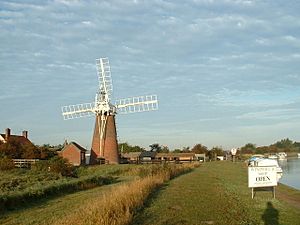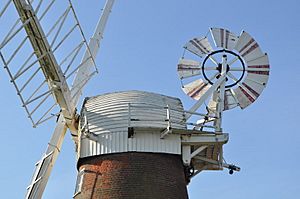Stracey Arms Windpump facts for kids
The Stracey Arms Windpump is a special kind of windmill found in Tunstall, a small place in Norfolk, England. It's not just any old building; it's a Grade II* listed building. This means it's a very important historical building that needs to be protected because of its special design and history.
This amazing windpump was built to help drain water from the land around it. Imagine a giant pump powered by the wind! It used to keep the nearby marshland from getting too wet by moving water into a channel that flowed into the River Bure. Even though an electric pump does the job now, the Stracey Arms Windpump is still a cool reminder of how people used wind power in the past.
Contents
What is the Stracey Arms Windpump Like?
The Stracey Arms Windpump is a tall, impressive building. It has four floors and a tower made of red bricks that gets narrower towards the top.
Key Parts of the Windpump
- The Cap: At the very top, it has a special roof called a "cap." This cap is shaped a bit like a boat and is covered with wooden boards.
- Sails: Just like a traditional windmill, it has large sails that catch the wind. These sails are connected to the machinery inside.
- Fan and Tail Pole: There's also a fan and a long "tail pole" that help the cap turn so the sails always face the wind.
- Inside Machinery: All the parts inside, like gears and shafts, are still working! They used to power a special pump called a "turbine pump."
This pump was super important for draining the wet marshland. It helped keep the land dry enough for farming and other activities.
A Look Back: History of the Windpump
The Stracey Arms Windpump has a long and interesting history, going back over a hundred years!
When Was it Built?
The windpump was built in 1883 by a person named Robert Barnes from Great Yarmouth. That's a long time ago, even before your grandparents were born!
Changes Over Time
- 1912: The windpump got some big updates and changes in 1912.
- World War II: During the Second World War, it was even used as a small fort! Soldiers added gun ports (small openings for guns) to its sides.
- 1946: After many years of hard work, the windpump stopped being used in 1946.
Bringing it Back to Life
- 1961: Starting in 1961, a group called the Norfolk Windmills Trust began to fix up the windpump. They worked hard to get it working again, just like it used to be.
- Today: Now, the windpump is open for visitors during the spring and summer months. Inside, you can see pictures that tell the story of how these amazing drainage mills helped shape the Norfolk Broads area. It's a great way to learn about history and how people used to live!



